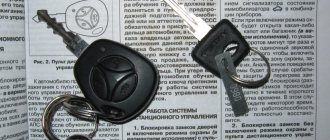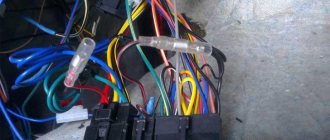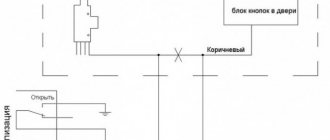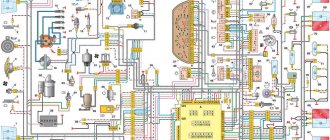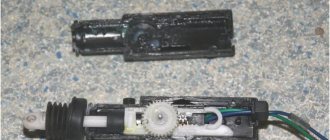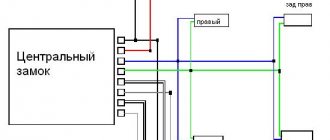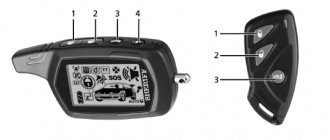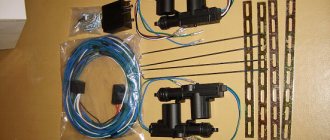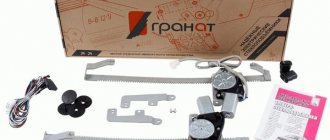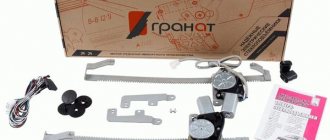Electronic devices in modern cars perform many functions, including protective ones. Nowadays almost no vehicle can operate without an alarm system. The necessary equipment is supplied as a kit and can be installed on your own without the involvement of specialists. All you need is a connection diagram and the correct placement of sensors and relays; by strictly adhering to the instructions, you can avoid an emergency.
Installation of the system on a VAZ 2107 car is carried out using mechanic tools:
- pliers;
- screwdrivers;
- wrenches;
- electric drill.
To check the relay and the correct installation, you will need a measuring device - a tester. When installing an alarm system, it is necessary to provide for the introduction of an emergency button into the control circuit. It is necessary to turn off the system in case of loss of the key fob; the wiring diagram will help you understand the order in which the components are connected.
We install autostart with our own hands
Before you begin the installation work of the autostart on the VAZ, you need to prepare everything required for this. Installing one alarm will not be enough; it will require long and painstaking work. To bring your plan into reality, you will need to prepare the following:
- alarm with auto start, in this case you can use the simplest model from ]StarLine;
- a temperature sensor and a controller are purchased separately;
- small electric drive, can be used from a Ladovsk washer;
- a thin cable, preferably soft, made of copper or aluminum, but it is better to give preference to the copper option;
- wiring in the required quantity, it is better to prepare with a reserve;
- In addition, patience will be required, since setting up equipment and autostarting a carburetor is a long and painstaking process.
Scheme for installing autostart on a carburetor
You can start assembly by turning off the manual choke, which is installed on any VAZ carburetor engine. In this case, you don’t have to pull out the cable, but secure it securely under the hood. There is a high probability that it will be useful for something in the future. If you have an auto choke on your car, then it will have to be completely disassembled. The carburetor is completely disassembled and all sensors are removed from it. The last step before assembly is to switch the feed drive to external.
Stages of installing a do-it-yourself autostart on a carburetor
To install a start-up signal on a carburetor engine, the following series of actions must be performed sequentially:
- First of all, all the components of the structure are placed in their places. The electric drive can be installed on the engine wall. The temperature sensor is mounted on the engine. You should not use an old sensor, as there is a high probability of making a mistake. The microcontroller will need to be placed next to the electric motor, although in some situations it is better to attach it to the carburetor.
- Using a previously prepared cable, the engine is connected to the damper.
- All parts of the suction pump should be connected to a microcontroller, which in turn has a direct connection to the signaling system.
- Next comes a test test, if the system gives a response, then you can move on to the next stage, if there is no feedback in the carb, then you have to recheck the entire connection again.
- The entire system is tested and brought to perfection. The microcontroller will have to change several operating modes taking into account the temperature sensor readings. You should also adjust the length of the cable as much as possible. Once the system has been tested, the first test run can be performed.
The final stage of installing autorun
It is possible to fully start the engine using the key fob only after installing the air damper servomotor. The device, as a rule, is placed on the wall of the engine compartment, while others, on the contrary, try to mount the element directly on the carburetor. By installing this element, you can forget about the position of the air barrier. This device is produced under the Sadko brand. The model is produced in two types:
- Standard equipment, which includes a microcontroller, control unit, cable, electric drive and temperature sensor.
- The maximum configuration, which contains all the previously listed devices, as well as some additions.
The maximum configuration of "Sadko" is distinguished by the following indicators:
- Having received a signal from the alarm key fob, the damper automatically opens slightly;
- Next comes fuel injection;
- after which, due to the control unit, a spark is supplied, which starts the engine for warming up.
If you decide to give preference to the standard set, then you will have to manually configure the entire system, since there may be a problem due to inaccurate calculations and installation, namely:
- The ignition is turned on first and the damper is closed manually;
- after the engine is running normally, you have to close the damper again with your own hands;
- after waiting for some time, you have to completely open the fuel supply;
- the machine should run for some time at idle speed without outside intervention;
- At the end the engine stops and cools down completely.
Upon completion of everything, all that remains is to test start the car with a button from a certain distance, which is accessible for the alarm.
Localization of central locking faults
All malfunctions of the central locking system (CL) can be divided into the following categories: complete or partial failure; The lock does not work or malfunctions due to mechanical or electrical defects or damage. When identifying malfunctions of the central locking system, you should rely on this classification and begin repairs not with any specific actions, but with diagnosing the equipment. This will save a lot of time, and possibly finances.
The central locking must function regardless of whether the car engine is running or not, and whether the ignition is on or not - the main thing is that the on-board network is not de-energized (the power terminals must be connected to the battery). The entire system consists of connecting wires, switches and:
- electric drives (solenoids or mechanisms with a motor) – electric central locking;
- vacuum drives, tubes, compressor and its control board - pneumatic (vacuum) central locking.
Actuators are usually called actuators or activators. A control drive is installed in the driver's door of the car, and also often in the front passenger door, which, when activated, sends an electrical signal through separate wires to open/close the remaining doors (to the control board or to the power relays of the remaining doors - only in the electric central locking system).
If you have a car alarm, repairs begin with testing it. If the central locking does not work from its portable remote control, then first of all you should check how it works from the key and the button for opening/closing the driver's door (and the front passenger door, if it also has a control drive). When the central locking is operated “manually”, you should look for a fault in the electrical and control alarm circuits. First of all, you need to check the battery of the remote control - it may be low.
FakeHeader
Comments 17
Heavy hehehehe. The corrugation is not for this car, you need to install rubber tubes that are specially designed for classics.
The actuator connector had to be cut off, twisted, ideally, soldered again... And the rods had to be wrapped with foam rubber so as not to rattle)...
PS: So I understand, the car is not yours, let the owner deal with this... For a couple of seconds. could have been done, of course, for an additional fee. fee).
The power of the actuators is not enough because the bimetal wiring is laid with a real cross-section of less than 0.7. This is called hack work. These wires are not even tinned. It's been like a year. I have already replaced the wiring for myself and my friends to 1.5 kV. The actuators fire even on a dead battery. Previously there were constant problems. Including periodic failures of actuators in different doors
I will not argue. Perhaps the wiring is bad, but this problem occurs even in cars with factory central locking (VAZ 2110 and modifications). And all problems were solved by removing the springs.
The exact definition of this action is “crutches”. By the way, I don’t have them either, since at one time I solved the problem along the path of least resistance. In the end, I had to do it for myself once and for all
It is better to install corrugations straight. These S-ki quickly dry out and crack, and they are compressed when the door is closed. Now just a classic in the works. True, I had to install two rubber bands, there are a lot of wires (activator, ESP, heated mirrors, speaker).
Basically, all rubber bands dry out and crack.
Corrugations are faster because they work in torsion all the time
It is better to install corrugations straight. These S-ki quickly dry out and crack, and they are compressed when the door is closed. Now just a classic in the works. True, I had to install two rubber bands, there are a lot of wires (activator, ESP, heated mirrors, speaker).
What exactly are these rubber bands called?
Strange ! Alarm? Are they being stolen? According to my Classic Wazen Tazen from Kopeyka to Semerka, Alarms and locks are no longer needed at all!
Well, I don’t know... for me, locks are a convenience, a way to automatically heat up and find out the temperature outside, and protection from dirty tricks.))
So the Center-Lock is separate, and the Alarm is also separate. You can install just a Center-Lock without an Alarm. I asked why the Old Lady had an alarm system.
Well, I wrote - the locks are there for convenience - so that in the cabin you don’t have to poke the flag on each door - but just press the button and all the doors are closed.))
I removed the entire signaling system and threw it away. I bought Center-Zamok (Vympel) and its remote controls are very beautiful. Everything seems to be working well! True, only a couple of weeks. I bought a new one, fortunately they were not expensive. Well, there are no problems with installation, two wires plus and ground. The second one worked longer for a couple of months and also went out. I spat, and now I use the key. It’s not summer, I don’t want to climb in the cold. So it turns out that now the problem is not with the cars, but with spare parts.
Strange ! Alarm? Are they being stolen? According to my Classic Wazen Tazen from Kopeyka to Semerka, Alarms and locks are no longer needed at all!
Basic connection diagram
Cord 3 here is the control one; it is connected to the starter terminal. And on the blue wire, that is, on terminal 15/2, the voltage may disappear when the starter is running, or it may remain on it all the time. When setting up, select one option.
VAZ 2101-2107 cars have their own characteristics. The coil of the additional relay shown in the diagram cannot be connected to the ignition cord going to the standard relay. The line is simply not designed for additional load!
Let's see what the ignition switch looks like in reality:
If you really need autostart, the starter cord (red) will have to be cut. Let's list what the correspondence between the lock and alarm cords looks like. The alarm cable will be indicated on the left:
- Green – free;
- Blue – free;
- Red – pink;
- Black-yellow thick – red (tap to starter);
- Black-yellow thin – red (bend to the lock);
- Yellow - blue thick.
In theory, everything turns out simple.
Of course, you can install the autostart system yourself. But it is better to entrust this task to a professional electrician. The three cords leading to the alarm must carry significant current. In new VAZ models the number of these cords will be no less.
Subtleties of engine control
If autostart is not used, the alarm should not read data from the engine. Otherwise, it is necessary to implement control that allows you to turn off the starter at the right time. The control itself is usually carried out like this:
- The signal can read the value of the supply voltage;
- The cord from the generator is connected to the terminal of the VAZ-2107 tidy - the control cable can be connected to this terminal;
- It is best to control the launch using the tachometer, for which the alarm will still need to be configured.
The third option is preferable. The cord is not connected directly to the tachometer terminal, but through a capacitor and resistor:
Generator and tachometer outputs
Direct connection is used for “generator” control.
In practice, only one control method can be used. First, installation and connection are performed, then the system is configured.
Handbrake control
The dashboard diagram of the VAZ Seven looks like this:
Internal wiring diagram
The cord from the handbrake limit switch goes to terminal 8 (connector X2). Connect to this contact unless the instructions indicate that a diode must be installed. Otherwise, use terminal 4.
Connecting to the 4th terminal if the diode is not specified in the basic diagram is incorrect. Remember this and be careful.
Didn't find the information you are looking for? on our forum.
Lada 2107 WORKING › Logbook › Installing an alarm system on a VAZ 2107
Well, in general, I decided to install an alarm on my car. Since ancient times, I bought a MONGOOSE EXPERT 800 car alarm, a regular alarm without bells and whistles, without feedback. To be fair, it is worth noting that 90 percent of the installation of an alarm system on a classic is plumbing work, there are a minimum of electrical connections, and it is not difficult to find connection points. 1. Installation of electric door locks
To do this, carefully remove the trim from the doors where we install the activators, and you need to have several new caps in stock, because break easily.
Electric locks are installed so that there is minimal load on them during operation. The actuator rod must be parallel to the standard rod. On the front doors this is done like this: the activator with the rod is applied to the door from the outside, and with an awl (or a sharpened rod) we mark it, and then we drill 2 holes like this:
We attach the rod to the standard rod as follows:
We route the wires in the door through the following rubber bushings:
Then we mark and drill coaxial holes in the door and pillar, depending on the rubber bushings, in my case 14 mm. In case of misalignment, we modify the hole in the door with a round file.
-Installation of activators in the rear doors of “classics”
Many car alarm installers do not undertake the installation of electric drives in the rear doors of VAZ classics. The reasons, of course, are clear: first of all, this is an extra waste of time, for which Zhiguli owners don’t really want to pay, then, installing drives in the rear doors is not as convenient as in the front ones, but with a strong desire, this work is not so difficult to do.
First of all, be sure to remove the locking spring from the lock.
If you are doing this for the first time, you can first remove the lock. I do this without removing the lock, using a slightly bent thin screwdriver. If the spring is not removed, the rod moves too tightly, and the activator cannot handle such a load.
We install the electric drive in the area of the mechanical lock, as shown in the figure. To do this, drill hole 1 for attaching the rear part of the drive, and holes 2 and 3 for attaching the mounting plate. The electric drive can also be positioned in the opposite direction, but this will require two mounting plates.
We attach the activator rod to the lock rod as follows, with bolts from below.
To lay the wire in the rear doors, we drill a hole along the diameter of the rubber bushing in the rack, 95-100 mm. below the bottom of the top door hinge. We also drill a coaxial hole in the door.
2. Installation of the hood and siren limit switch
We lay the wires into the engine compartment through the rubber seal where the headlight hydraulic adjustment tubes pass, carefully drilling a hole.
We install the siren on the same fender liner near the air filter.
3. Installation of the trunk limit switch and electric trunk opening drive
For the trunk end, we saw off the mounting plate and bore one slot to 6 mm.
To remotely open the trunk in the trunk lock, cut the following slot on the sandpaper with a cutting wheel:
We attach the electric drive to the trunk lid and connect it to the lock with a flexible cable, for example from a vole, crimp and solder the ends of the cable. I made a lot of cars this way and had no complaints.
4. Electrical connections
There are few electrical connections, and they are made behind the instrument panel. You can also connect to the fuse block connectors, but on injection models it is not easy to get to them. We connect the plus and ignition to the ignition relay, brown and blue wires, respectively. The relay is located next to the turn signal relay.
We connect the turn signals on the block on top of the steering column to the blue and blue with a black stripe wires.
We take the signal from the door switches from the white/black wire behind the side panel near the clutch pedal (you can also behind the right side panel)
source
Step-by-step instruction
Defense System Kit
Due to the extra time spent, car owners often refuse to install activators in the rear doors of their vehicle. However, this procedure is not complicated. Initially, you will need to remove the retaining spring. You can do this in 2 ways:
- removing the lock,
- using a thin, slightly bent screwdriver without removing the lock.
Otherwise, due to the tight movement of the rod, the activator will not be able to cope with the load placed on it. The electrical wire must be installed in the area of the mechanical lock. To do this, you will need to make a hole to fix the back of this installation and 2 holes for the plate. The electric drive can be positioned in the opposite direction. In this case, installing an alarm system on a VAZ 2107 with your own hands involves the use of 2 plates.
The activator rod is fixed to the rod using bolts. As for laying the wire itself, this will require making a hole in the rear doors, the diameter of which will coincide with that of the rubber bushing. This should be done 95-100 mm lower than the lower part of the upper hinge of the rear door. You will also need to make a coaxial hole in it.
Next, install the wires under the hood. They need to be laid through a seal. To do this, a hole is made in the place where the headlight hydraulic corrector tube passes. The siren and limit switch are mounted on a slightly bent mounting plate.
The luggage compartment limit switch provides for sawing off the mounting plate and the electric drive for opening the trunk itself. When attaching the limit switch, it is not recommended to completely unscrew the nut. Otherwise, it will be difficult to lock the spring back. To install it, a slot is made in the trunk lock. The electric drive should be secured to the trunk lid. A flexible cable can be used as a connecting element.
How to use the ignition switch
Any alarm equipped with auto-start is usually equipped with 5 power terminals:
Basic connection diagram
Cord 3 here is the control one; it is connected to the starter terminal. And on the blue wire, that is, on terminal 15/2, the voltage may disappear when the starter is running, or it may remain on it all the time. When setting up, select one option.
Let's see what the ignition switch looks like in reality:
Terminal block of standard lock
If you really need autostart, the starter cord (red) will have to be cut. Let's list what the correspondence between the lock and alarm cords looks like. The alarm cable will be indicated on the left:
- Green – free;
- Blue – free;
- Red – pink;
- Black-yellow thick – red (tap to starter);
- Black-yellow thin – red (bend to the lock);
- Yellow - blue thick.
In theory, everything turns out simple.
Of course, you can install the autostart system yourself. But it is better to entrust this task to a professional electrician. The three cords leading to the alarm must carry significant current. In new VAZ models the number of these cords will be no less.
Installation of alarm systems VAZ 2101, 2106, 2107
0:47
- Installation of the StarLine A91 alarm system on the injection classic VAZ 2101
- Connecting the trunk to the alarm using a button
- Differences between the original StarLine system and the fake
- Installation of an alarm system in a VAZ 2101
- We connect the hood and trunk limit switches in the VAZ 2106
Installation of the StarLine A91 alarm system on the injection classic VAZ 2101
What you need: StarLine A91 starline activator for 4.5 kg (took 3 pieces) adjustable limit switch (took 2 pieces) tubes in the door (took 4 pieces) double wire 0.5mm2 (15 meters) terminals 1.5mm2 (20 pieces female, 20 pieces male) the rest was: soldering iron, pliers, scissors, electrical tape, heat shrink, screwdriver, drill, self-tapping screws
Preparing for installation
Installing an alarm system on a VAZ 2107, 2106, 2105 does not require special knowledge or extensive experience. To install the anti-theft system you will need the following tools:
- screwdrivers
- electric drill
- spanners
- pliers
- tester
To begin installing a car alarm, you need to partially disassemble the interior, or rather, remove the front panel and door trim, including the handles for opening and closing the glass. To gain access to the ignition switch, you must remove the cover from the steering column.
Before installing the alarm system on a VAZ 2107, 2106, 2105 with your own hands, you need to assemble all its components in advance and test them for functionality by connecting them to the battery. The anti-theft system kit includes a main unit, a contact relay, limit switches, an alarm button, wires with lugs and a central lock. The main unit must be installed as secretly as possible to make it difficult to access. The wiring should also be hidden from prying eyes or simulate the network of another mechanism using colored insulating tape.
To make the electrical circuit under the hood difficult to access, you should hide it behind large parts, but away from hot and moving parts. The sound system must be installed so that it can only be accessed after opening the car.
Preparation for work
Installation of the system on a VAZ 2107 model car begins with partial disassembly of the interior. The order of work is as follows:
- The upholstery is removed from the doors: the fastening screw is unscrewed with a Phillips screwdriver. The handles for lowering the glass and opening the doors, as well as the armrest, are removed from the panel.
- The vertical part of the center console is removed; to do this, you need to unscrew all the fastening screws.
- The plastic cover is removed from the steering column; this is necessary to gain access to the ignition switch and the control button for the standard hazard warning lights.
Before installing the system, you need to check its functionality by assembling it on a table and connecting it to the battery.
The alarm system is usually purchased in a store, and the delivery package must be checked. It includes: a central unit, an executive relay, central locking solenoids, wires with lugs and limit switches. The listed emergency system equipment must be placed secretly in the cabin so that it is not easily accessible. If you do the installation and connection yourself, you should carefully study the instructions.
Initial stage of work
Reliable car protector
You can install an alarm on a VAZ 2107 using an awl, a drill, a chisel, a drill, screwdrivers, a file, wire cutters, a tester, and electrical tape.
Before installing and connecting the alarm, an electric lock is installed on the front door. It should be remembered that the alarm can be connected from the negative and positive polarity of the sensor. However, not every installation of this type provides this opportunity. The first case is characterized by connecting the black wire to the body, and the white wire to the sensor with negative polarity.
Before installing the electric lock on the rear doors, please note that you will initially need to bend the electric lock rod into the shape of the letters “V” or “Z” with your own hands, and then cut it off. There is little space available for such work, so experts recommend proceeding carefully.
The important points in this matter are the following.
- Dismantling door trim where activators are to be installed. It is recommended to have several caps in stock, as they break easily.
- Electric locks are installed taking into account the minimum load that will be placed on them during operation.
- The location of the drive rod is parallel to the standard rod. When carrying out this work on the front doors, you will need to attach the rod with the activator to its outer side, making a mark using an awl. Then 2 holes are made.
- Routing wires through rubber bushings.
- The holes in the rack and the door are made coaxial, taking into account the dimensions of the bushings. Otherwise, the hole is made using a file.
Installation of components and routing of circuits
The placement of blocks with relays on a VAZ 2107 car is usually done in the central panel. The wires are first connected to the device as required by the connection diagram. Then the central block is placed in place and glued to the panel from the inside by hand, or secured with self-tapping screws. The wires are laid under the decorative panels and trims to the installation points of the actuators and sensors.
Do-it-yourself installation of system components on a VAZ 2107 car is carried out in the following sequence:
- Solenoids are mounted in the doors so that the lock rods can move under their influence. The diagram according to which the alarm is installed usually contains explanatory drawings to facilitate the work.
- After the installation of the magnets is completed, they are connected using the wires from the kit.
- A relay is installed in the ignition circuit, which makes it impossible to start the engine when the system is on. It is turned off by an emergency button.
- In the engine compartment, as the circuit provides, a speaker is mounted.
Upon completion of all work on the VAZ 2107, the functionality of the device is checked and the panels are installed in the reverse order of removal.
Installation and connection of additional elements
Many cars do not have hood, trunk, or fuel filler door sensors. You can purchase limit switches, connect them in parallel and connect them to the control input. This is how, for example, they install the hood button:
Installation of the sensor-button
One subtlety must be taken into account - the “open” position must correspond to a closed state. Installation is carried out in the following sequence:
- Secure the switch body;
- Additional wires are passed through the seal where the hydraulic corrector tubes pass;
- Connect the sensor, and at the same time the siren.
Now let’s add movement control to the car, that is, the alarm will “know” whether the car is actually moving.
Features of standard electrical wiring
First you need to clarify what exactly needs to be connected if the installation is performed without autorun:
- Ignition control;
- Power supply for the alarm itself;
- Door switches;
- Handbrake switch;
- Signal lamps (2 wires).
As you can see, the number of elements here is kept to a minimum. But even using this, that is, a minimum set of points, will allow you to quickly connect a turbo timer. Simply, in cars of the 2107 family, the ignition support relay is installed as standard. And you need to use this.
Look at the diagram and you will understand what we are talking about:
Elements of standard car wiring
In general, the figure shows all the important elements:
- Ignition support relay.
- Outputs for light signaling (blue and black-blue). The 8-pin connector is located in the steering column.
- Door control wire. It is located in the side tunnel near the clutch pedal.
Make T-branches and connect any signaling. By the way, the power supply to the lamps (second photo) is connected through fuses. Which is true for any car, not just the VAZ-2107.
1. Car alarm connection points for VAZ 2107 2008
All connections are made behind the glove compartment.
+ 12 — pink ignition — blue thick ignition 2 — blue/black thick starter — red thick fuel pump — gray, to the relay block behind the glove compartment handbrake — brown charging — brown/white tachometer — brown/blue door limit switches (-) — white/black from the passenger door switch, turns - blue and blue/black, dimensions - yellow/red
Cenmax ST7 works great on the tachometer
How to use the ignition switch
Any alarm equipped with auto-start is usually equipped with 5 power terminals:
Cord 3 here is the control one; it is connected to the starter terminal. And on the blue wire, that is, on terminal 15/2, the voltage may disappear when the starter is running, or it may remain on it all the time. When setting up, select one option.
Let's see what the ignition switch looks like in reality:
If you really need autostart, the starter cord (red) will have to be cut. Let's list what the correspondence between the lock and alarm cords looks like. The alarm cable will be indicated on the left:
- Green – free;
- Blue – free;
- Red – pink;
- Black-yellow thick – red (tap to starter);
- Black-yellow thin – red (bend to the lock);
- Yellow - blue thick.
In theory, everything turns out simple.
Of course, you can install the autostart system yourself. But it is better to entrust this task to a professional electrician. The three cords leading to the alarm must carry significant current. In new VAZ models the number of these cords will be no less.
Causes of malfunctions
If the central locking stops working, you must first check the fuse box. Short circuits and various disturbances often occur in the central locking system, which leads to blown fuses.
Checking system fuses
The central lock does not operate when the battery is completely discharged. To check, you need to open the central locking with the key and try to start the car. If it does not start, then the reason is the battery is discharged.
The reason why the central locking system does not work may be due to a breakdown of the electronics. You can open the car without a key using the key fob. If the central locking does not open with the key fob, you should check the batteries and buttons of the key fob. They may stick and not work at the right time.
At the next stage, using the instructions, you should check the alarm control unit. It is possible that due to problems with it, the central locking works, but does not close all the doors. The last thing to check is the microboard, which is located on the activator motor, and at the same time the drive itself should be checked. Defective parts must be replaced.
Electrical circuit diagram for central locking
If the central locking does not work, this may be due to mechanical problems: the cylinder drive hose is faulty. The signal received by the control unit from the key fob is transmitted to the motor on the doors, which should operate and act on the hose fixed in the cylinder. If one end of the hose falls out of the cylinder, the drive is turned off. In this case, the door will not be able to open or close. Thus, the reasons why the lock does not work or malfunctions can be either electrical or mechanical.
Read, it may be useful: Repair of armrests of the VAZ-2107
How to use the ignition switch
Any alarm equipped with auto-start is usually equipped with 5 power terminals:
Cord 3 here is the control one; it is connected to the starter terminal. And on the blue wire, that is, on terminal 15/2, the voltage may disappear when the starter is running, or it may remain on it all the time. When setting up, select one option.
Let's see what the ignition switch looks like in reality:
If you really need autostart, the starter cord (red) will have to be cut. Let's list what the correspondence between the lock and alarm cords looks like. The alarm cable will be indicated on the left:
- Green – free;
- Blue – free;
- Red – pink;
- Black-yellow thick – red (tap to starter);
- Black-yellow thin – red (bend to the lock);
- Yellow - blue thick.
In theory, everything turns out simple.
Of course, you can install the autostart system yourself. But it is better to entrust this task to a professional electrician. The three cords leading to the alarm must carry significant current. In new VAZ models the number of these cords will be no less.
Installation points for any alarms in classic VAZ cars: model 2107
In VAZ-2107 cars, connecting a door sensor couldn’t be easier: there is one wire that is shorted to ground when any door is open. The cord from the handbrake sensor is routed to the “tidy”, and in the adjacent connector there is a tachometer contact. In general, the owner can install a “regular” alarm system that does not have auto start without any help. A more complex option, when connected to the ignition switch, is also discussed in our text. In the first case, by the way, you can use the turbo timer. Let's start considering this option right now.
Sound signal device
The sound signal on the VAZ 2107 comes in the following versions:
- Two separate signals: type S-304 (low tone) and S-305 (high tone). Mounting - on the bracket, to the left of the radiator.
- The only non-separable signal of type 20.3721-01, one tone, with a built-in relay. Mounting is on a bracket outside the radiator, immediately behind the decorative grille.
The operation diagram of the sound signal is as follows: two wires are connected to the sound signal itself. The red wire is “plus”. This part of the circuit is constantly energized. The gray-black wire is “ground, minus”; in the normal state it is de-energized, and current begins to flow through it when shorted. The photo clearly shows the color of the wires and two separate signals with brackets.
The “negative” part of the chain is long. When you press the central steering wheel button, the spring contacts close. They are located in the switch housing under the steering wheel.
The slip ring is attached to the back of the steering wheel. Its task is to ensure good contact through friction and provide a signal whenever the steering wheel is turned. Therefore, the ring must be lubricated with conductive graphite lubricant to avoid wear.
Then, the current is transmitted through the wire as part of the engine compartment harness to the switch and relay mounting block. The location of the horn relay (switch) is third on the right (if you are sitting behind the wheel).
Horn relay functions:
- The length of wires and current losses in them are reduced.
- With the help of a relay, a button with a small current can control a circuit with a large load.
Sometimes the circuit does not provide a relay; instead, a jumper that is connected “directly” works. In the case of a single signal 20.3721-01, this is justified, since it has a built-in relay. If there are two “snails”, it is advisable to install a relay to improve operation.
After the relay, the current passes through fuse F7. The new mounting blocks have a 20 A flag-type fuse, yellow. Older units have 16 A fuses. Their lifespan is often insufficient, since this fuse also serves in the cooling fan circuit.
Further, after leaving the mounting block as part of the wiring harness of the engine compartment, the “negative” wire goes directly to the sound signal.
Availability of central locking
Using a tester, we find the necessary wires (ignition, turn signals, buttons for opening doors, 12V and central locking). The absence of a central lock forces the door trim to be removed in order to install an electric drive. It needs to be connected to the alarm unit. You will find all this in the instructions. Nobody forbids you to install an electric drive on all the doors of your car. In the threshold of the car there is a harness with wires for limit switches and turn signals. This threshold leads to the trunk. If you do not find these elements in your car, then you will have to install them manually. As a rule, you can find them in the alarm kit.
3. Connection points for car alarms on VAZ 2114 2008 - 2010
ChainColorPolarityLocation+ 12VPinkPositiveIgnition switchStarterRedIgnitionBlue/blackDriver's doorBlue/whiteNegativeIndication unitRemaining doorsGray/blackTrunkInstall limit switch. (But it’s not possible to install it there! I didn’t install it...) Central locking * Blue and brown Negative Harness from the central locking unit (top left, above the clutch pedal) Turns Blue and blue/black Positive Harness, on the left of the clutch pedal, under the mat or on the emergency brake button Handbrake Brown/blue Negative Noodles- harness, left clutch pedal, under the mat Engine operation can be monitored using any of the signals:Tachometer Brown/red Instrument panel. Connect through a non-polar capacitor 2 µFChargingBrown/WhitePositiveInstrument Panel*You may need to install a 5-wire electric. lock on the driver's door. Connect the lock to the central locking unit to the thick Red and Yellow wires. It is possible that cr. and yellow. The wires are already installed in the driver's door, you can connect the lock to them. If not, you will have to throw it into the cabin and connect it to the central locking unit, to the same yellow one. and cr. wires. The limit switch, which is inside the el. lock, connect it to the place of the standard limit switch, which is on the lock, in the door. The wires are black (ground), blue, brown (open/closed).Installing the Valet button
The Valet button is included with every anti-theft system. It completely disables the alarm and allows you to reprogram it.
If you install an alarm system on a VAZ 2107, 2106, 2105 with your own hands, you can install the Valet button in the most convenient place for you. The main thing is that it is invisible and difficult to access. It is rarely used, since you need to turn off the alarm in case of breakdown or failure, and also if you want to reprogram it. Each other alarm model connects the Valet button differently, so it is better to use the installation instructions for a specific model.
Types of car alarms
One-way signaling is considered the simplest and most accessible. Despite the minimum number of functions, or rather, engine blocking and control of locks on the doors and trunk, it copes with the main function. A minimum distance of about 100 meters is required between the car and the system key fob for good functioning.
In addition to standard functions, the two-way anti-theft system has additional ones that slightly expand the functionality. This system notifies the owner with sound signals about a break-in or attempted access, and information is also sent to the key fob display. A car alarm with auto engine start is essentially two-way. The difference is the engine control at a certain distance, about 200-300 meters.
The interactive anti-theft system recognizes the owner through dialogue. Newer models have Internet access and allow you to track the location of the car. Alarms with auto start and other functions are quite expensive, so the most functional models are installed on the corresponding cars.
